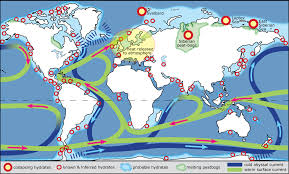Large amounts of methane – whether as free gas or as solid gas hydrates – can be found in the sea floor along the ocean shores. When the hydrates dissolve or when the gas finds pathways in the sea floor to ascend, the methane can be released into the water and rise to the surface.
Once emitted into the atmosphere, it acts as a very potent greenhouse gas twenty times stronger than carbon dioxide. Fortunately, marine bacteria exist that consume part of the methane before it reaches the water surface.
Geomicrobiologists and oceanographers from Switzerland, Germany, Great Britain and the U.S. were able to show in an interdisciplinary study that ocean currents can have a strong impact on this bacterial methane removal. The international scientific journal Nature Geoscience has published the study.
The data was collected during an expedition in the summer of 2012 aboard the research vessel MARIA S. MERIAN. At that time, the international research team was studying the methane seeps off the west coast of the Norwegian Svalbard archipelago.
“Already then, we were able to see that the level of activity of the methane consuming bacteria changed drastically over very short time spans, while at the same time many oceanographic parameters such as water temperature and salinity also changed”, explains Lea Steinle, first-author of the study and PhD student at the University of Basel and the GEOMAR Helmholtz Centre for Ocean Research Kiel. For her PhD thesis, Steinle studies where and how much methane is consumed in the ocean water column by bacteria.
In order to test if the fluctuations measured during the four weeks of the expedition were only random observations or based on typical and recurring processes, oceanographers of the GEOMAR later took a closer look at the region with a high resolution ocean model.

